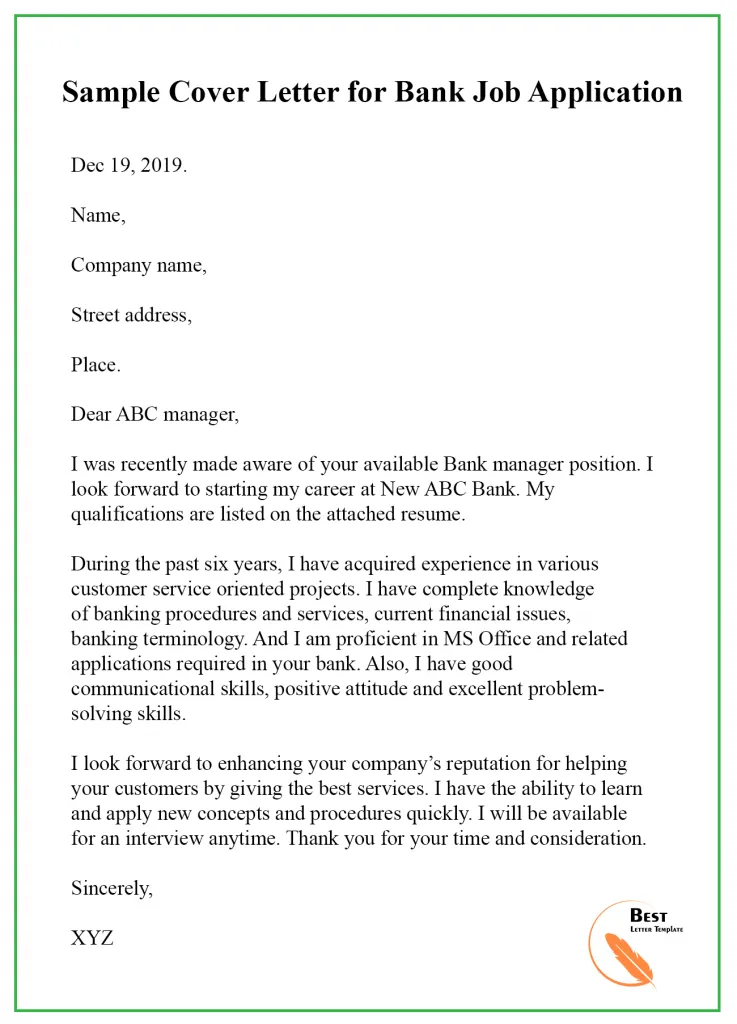What is a Bank Cover Letter?
A bank cover letter is a crucial document accompanying your resume when applying for a job in the banking sector. It serves as your first introduction to a potential employer, providing a personalized overview of your qualifications, skills, and experience. Unlike a resume, which is a factual summary, a cover letter allows you to express your personality, demonstrate your interest in the specific role and bank, and highlight how your capabilities align with the company’s needs. A well-crafted bank cover letter can significantly increase your chances of securing an interview by making a strong first impression and setting you apart from other candidates.
Key Components of a Bank Cover Letter
To create a compelling bank cover letter, you need to include several key components that present you in the best possible light. These components work together to form a cohesive narrative that captures the hiring manager’s attention and encourages them to delve deeper into your qualifications. From the header to the closing, each section contributes to a professional and impactful presentation, ensuring you make a memorable and positive impression. By carefully crafting each element, you can showcase your suitability for the role and your genuine interest in joining the bank’s team.
Header Information
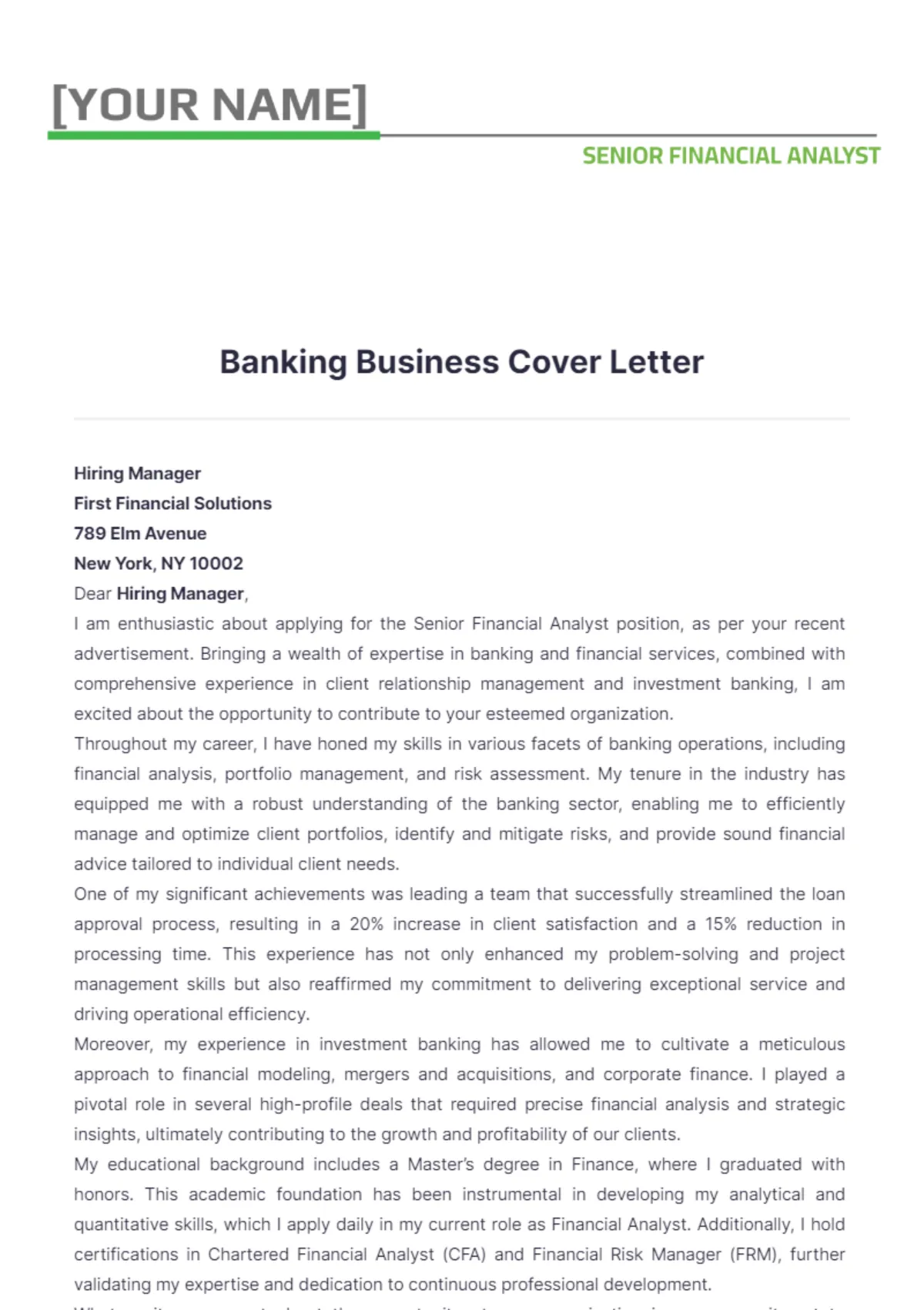
The header of your bank cover letter is the first thing the hiring manager will see. It should include your contact information, such as your name, address, phone number, and email address. This information should be clearly displayed, typically aligned to the left or right margin, ensuring easy readability. The header sets a professional tone and provides the recruiter with the necessary details to contact you. Make sure your contact information is accurate and up-to-date to avoid any delays in the application process. Using a clean and professional font for your header further enhances the overall presentation.
Applicant’s Contact Information
In the applicant’s contact information section, start with your full name at the top, followed by your complete mailing address. Include your current phone number, ensuring it’s a number where you can be easily reached. Finally, provide a professional email address; avoid using informal or unprofessional email handles. Consider using a consistent font and size throughout this section for a polished look. Double-check all details for accuracy to prevent any communication issues with the potential employer. Proper applicant contact information is vital for the hiring manager to reach you regarding the job application.
Date
The date is a crucial piece of information in your bank cover letter, and it needs to be accurate. This should be the current date when you’re submitting your application. The date is typically placed below your contact information and can be aligned to the left or right, depending on your layout preferences. Proper date placement ensures your cover letter is timely and helps the employer keep track of when you applied. Formatting the date correctly adds to the overall professional presentation of your cover letter, showing attention to detail.
Hiring Manager’s Contact Information
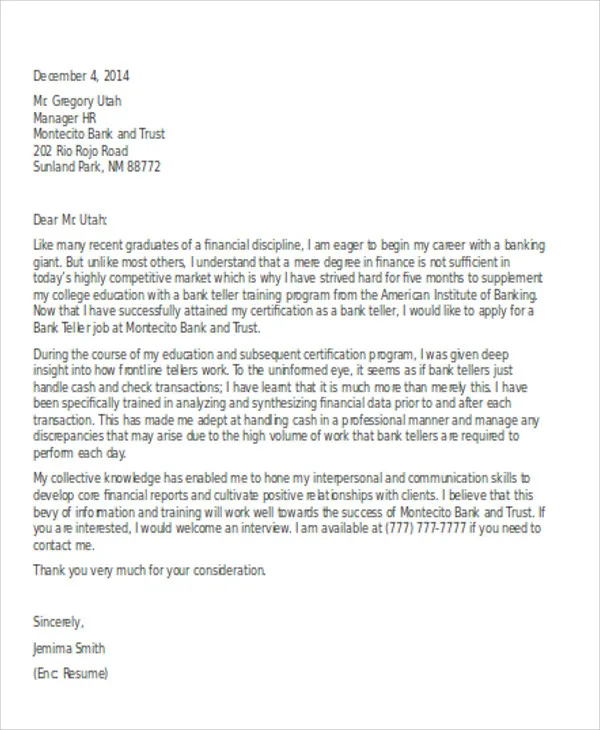
When addressing the hiring manager, always aim to personalize your cover letter. Start with the hiring manager’s name and title, if known. If possible, research the specific hiring manager or recruiter for the role you’re applying for. If you can’t find a specific name, use the department’s title, like “Hiring Manager.” This personalized approach shows you’ve done your homework and are genuinely interested in the position. Ensure accuracy by double-checking the spelling and title to demonstrate professionalism. Personalizing the letter can greatly enhance your application and show your attention to detail.
Salutation
The salutation is your formal greeting. If you know the hiring manager’s name, use “Dear [Mr./Ms./Mx. Last Name].” If you’re unsure of the name, “Dear Hiring Manager” is appropriate. Avoid generic greetings like “To Whom It May Concern” as they lack personalization. Keep the tone professional and respectful. Using a proper salutation is the first step in establishing a positive and professional rapport with the reader, setting a formal tone for the letter.
The Introduction Paragraph
The introduction paragraph sets the tone for the rest of your cover letter. State the specific position you are applying for and where you found the job posting. Briefly mention why you are interested in the role and the bank. Clearly convey your enthusiasm and make a strong first impression. Highlight one or two key skills or experiences that directly align with the job requirements. Keep it concise and engaging to capture the reader’s attention right away. The introduction is your first opportunity to showcase your fit and interest.
Highlighting Your Skills and Experience
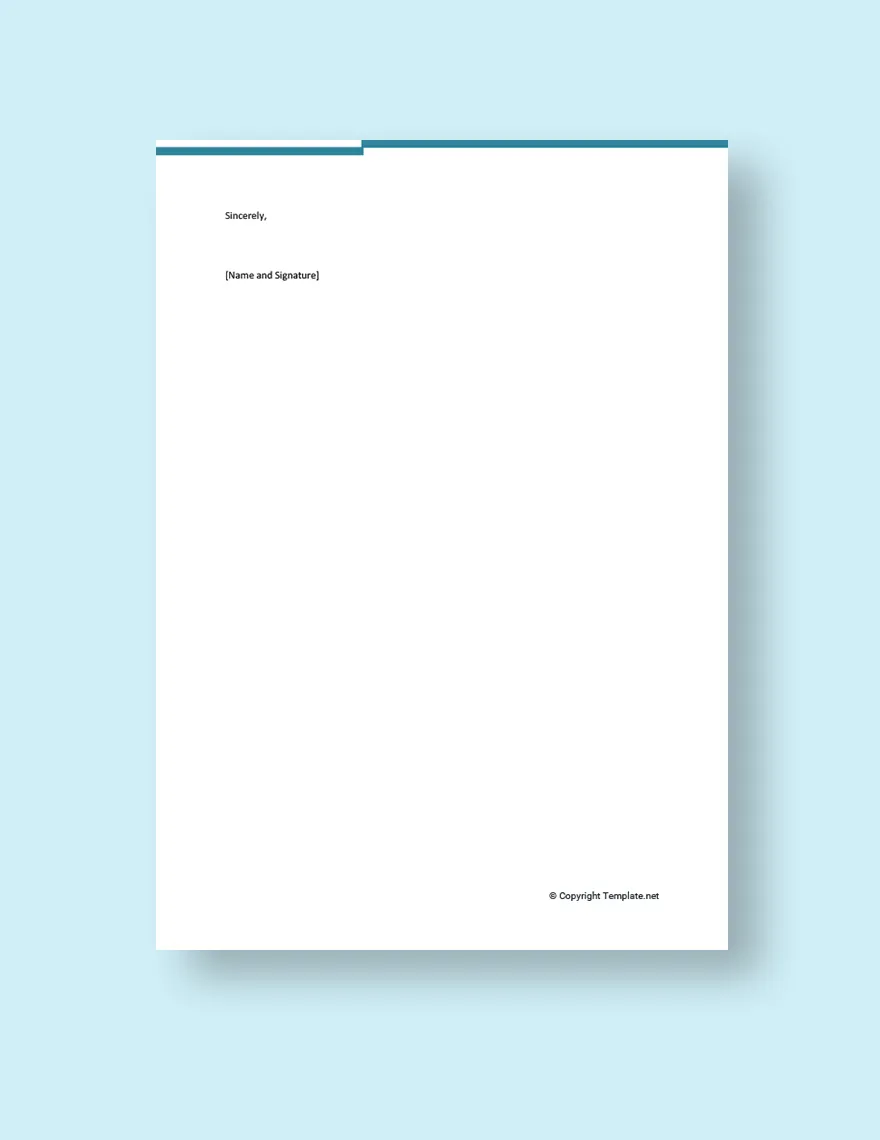
The core of your bank cover letter should focus on your skills and experience. Match your abilities to the job description, emphasizing the qualities that make you a good fit. Provide specific examples to demonstrate your skills. Whether it’s customer service, financial analysis, or risk management, show how you’ve used these skills in previous roles. Use action verbs to describe your accomplishments and quantify them whenever possible. This section must prove you have what it takes to succeed in the role.
Quantifiable Achievements
Quantifying your achievements is essential in making your bank cover letter impactful. Instead of simply stating you “increased sales,” mention by what percentage you increased sales and over what period. If you improved customer satisfaction scores, provide the exact increase. Numbers add credibility to your claims. Using metrics like percentages, numbers, and dollar amounts demonstrates tangible results. The goal is to show the value you brought in previous roles. These verifiable results set you apart from applicants and show you will provide tangible returns to the bank.
Tailoring Your Letter to the Bank and Role
Personalization is crucial for a successful bank cover letter. Tailor your letter to the specific bank and role you are applying for. This shows that you have taken the time to understand the bank’s culture and values and how your skills align with the job requirements. A generic cover letter indicates a lack of genuine interest. Address the bank’s mission, values, and recent news. Show that you have researched the company and understand its goals, proving that you are the right fit for the opportunity.
Researching the Bank’s Values and Culture
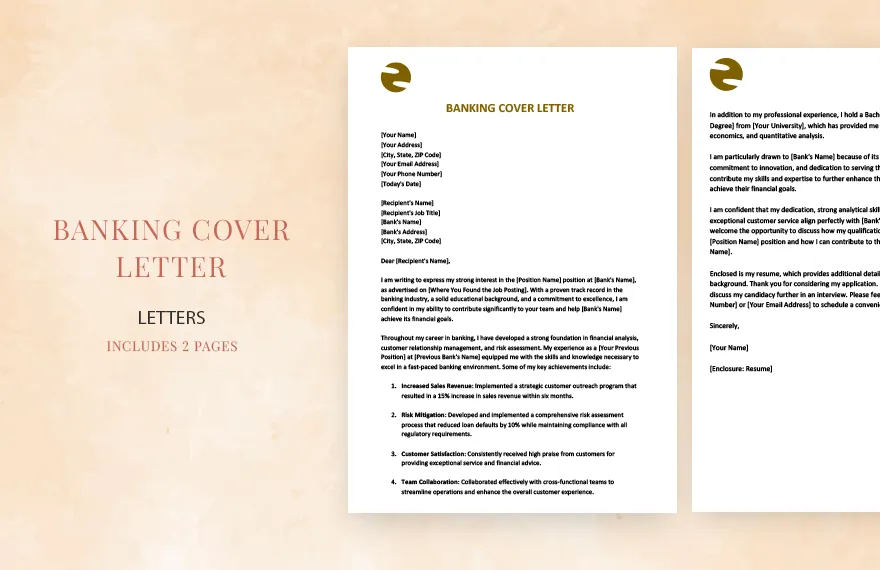
Before you start writing, research the bank’s values and culture. Visit the bank’s website, read their mission statement, and look at their recent news and initiatives. Identify the core values that resonate with you and your career goals. This research will help you tailor your cover letter, demonstrating your understanding of the bank’s specific objectives. Incorporate these values into your letter, showing how your skills and experience align with the bank’s culture. Showing you understand and fit the company culture can dramatically increase your appeal to hiring managers.
Matching Skills to Job Requirements
Carefully analyze the job description, noting key skills and qualifications the bank seeks. Then, match your skills to the specific requirements listed. Give specific examples of how you’ve demonstrated those skills in past roles. Use keywords from the job description in your cover letter. Emphasize the relevant experience that aligns with the role. Aligning your abilities with the job needs shows that you have what it takes to succeed in the role and that you understand the responsibilities. This targeted approach makes your application more appealing.
Expressing Enthusiasm and Interest
Expressing genuine enthusiasm and interest in the position and the bank is a must. Let your passion shine through in your writing. Explain why you are interested in this specific role and what excites you about working for the bank. Mention something specific about the bank that attracts you, whether it is its commitment to the community, its innovative approach to banking, or its employee-friendly culture. Show the hiring manager that this is more than just a job for you, it’s a career you are genuinely passionate about pursuing. Enthusiasm makes you memorable.
The Closing Paragraph
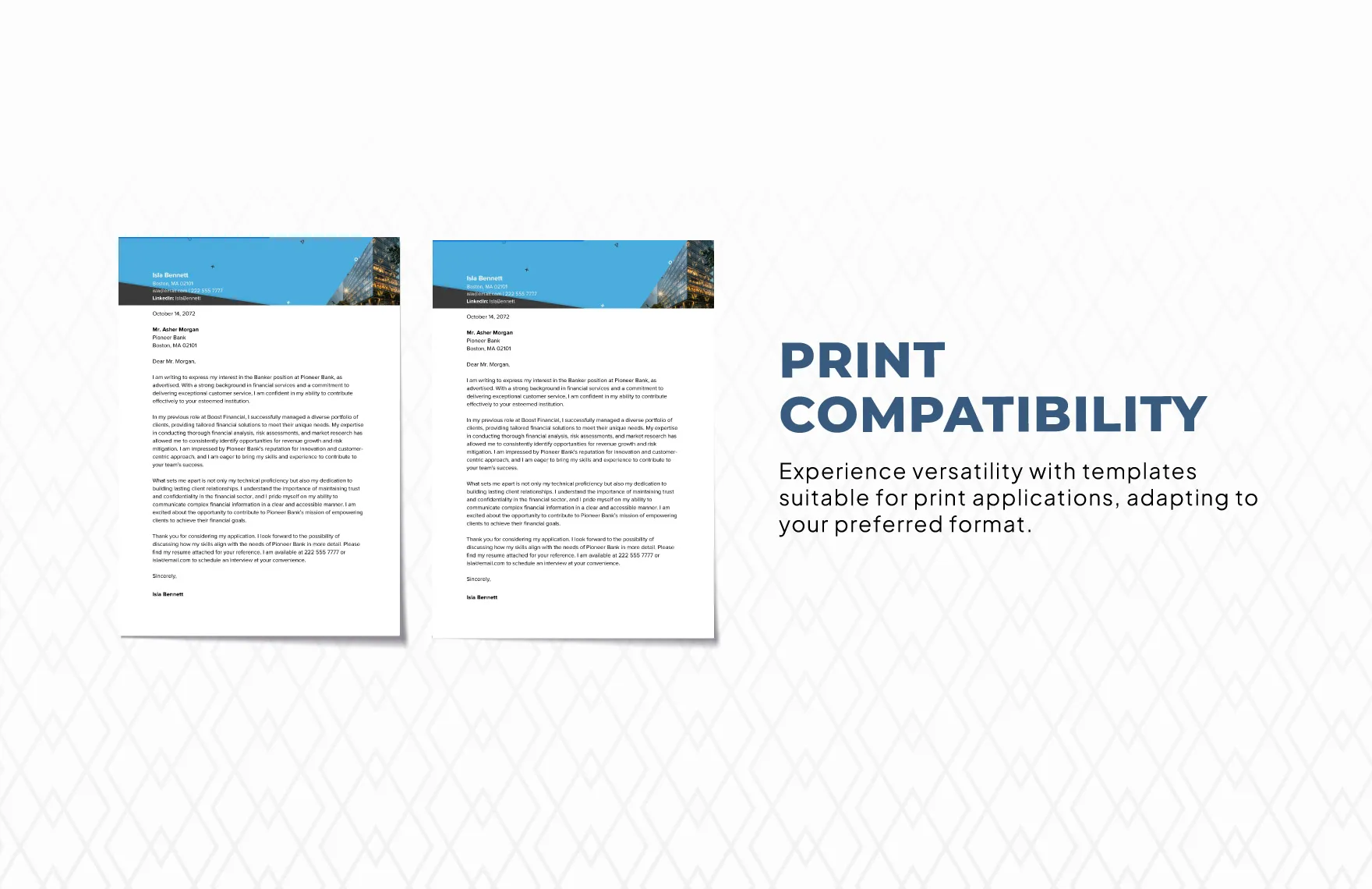
Your closing paragraph should summarize your interest and reiterate your qualifications. Thank the hiring manager for their time and consideration. Restate your enthusiasm for the role and the bank, emphasizing your desire to contribute to the team. Your closing should be confident and optimistic. This paragraph should leave a lasting positive impression. Make it clear that you’re ready to take the next step in the hiring process.
Call to Action
Include a call to action in your closing paragraph. State that you are available for an interview and provide your contact information again. Make it easy for the hiring manager to reach out to you. You can use phrases such as “I look forward to hearing from you” or “I am eager to discuss how I can contribute to your team.” Providing a clear call to action ensures that the hiring manager knows your next steps. This directs the hiring process, increasing the likelihood of you being contacted.
Formal Closing and Signature
Choose a professional closing such as “Sincerely,” “Respectfully,” or “Best regards.” Ensure your closing aligns with your overall tone and content. Leave space for your signature, and type your full name below the closing. Your signature is crucial for formal and professional applications. Ensure that your signature is legible and consistent with the rest of your cover letter. This final touch reinforces professionalism, providing the recruiter with your contact details.
Proofreading and Formatting
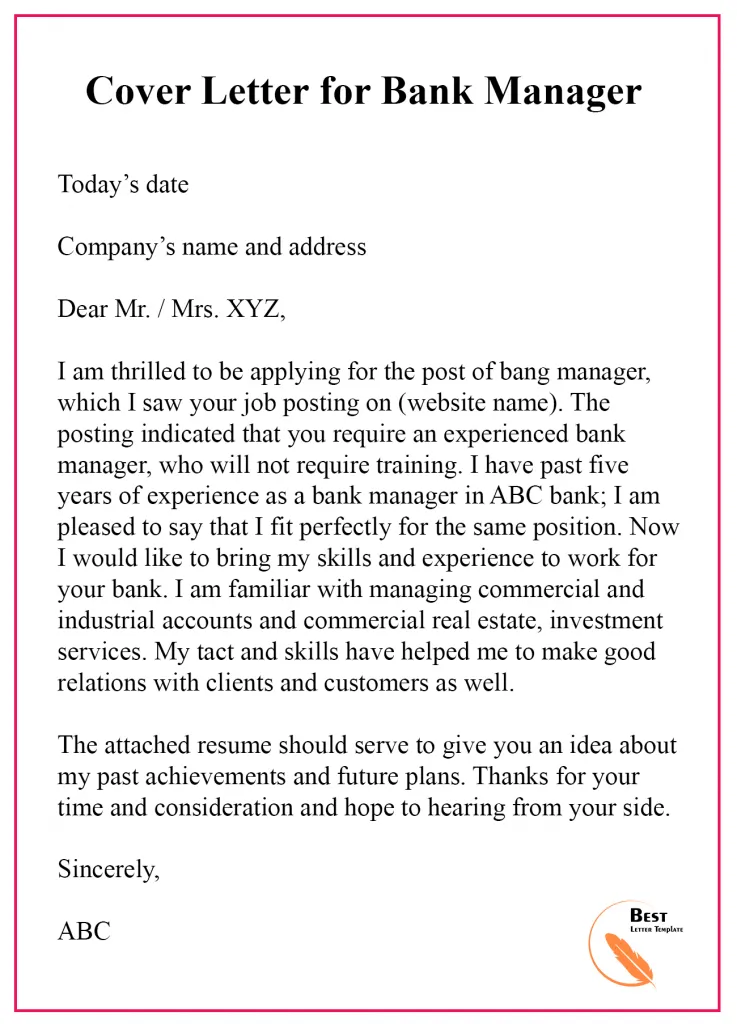
Before submitting your bank cover letter, proofread it carefully. Check for any grammatical errors, spelling mistakes, and punctuation issues. Ensure that your sentences flow logically and that your writing is clear and concise. Typos and errors can undermine your credibility, so take the time to meticulously review your document. Consider having a friend or colleague proofread it as well. This extra step can help you catch any mistakes that you might have missed. Careful proofreading can vastly improve your application’s quality.
Formatting Tips
Use a professional font, such as Times New Roman, Arial, or Calibri, for readability. Maintain a consistent font size, typically 11 or 12 points. Use single spacing within paragraphs and double spacing between paragraphs. Keep the margins at one inch on all sides. Avoid using excessive formatting or colors. Your cover letter should be easy to read and visually appealing. Proper formatting shows your attention to detail and makes your cover letter more accessible to the hiring manager. Well-formatted documents highlight your care and professionalism.
Proofreading Checklist
Use a proofreading checklist to ensure you’ve addressed every detail. Check for spelling errors, grammatical mistakes, and punctuation issues. Ensure your sentences are clear and concise. Verify that all contact information is correct. Confirm that your formatting is consistent. Have someone else review your cover letter for feedback. Proofreading is a critical step in the job application process. Completing each step on the checklist will help you avoid making easily avoidable errors and improve your chances of landing the job.
In conclusion, a well-crafted bank cover letter is a powerful tool that can significantly enhance your job application. By following these guidelines and tailoring your letter to each specific role and bank, you can showcase your skills, experience, and enthusiasm effectively. Remember to always proofread your letter carefully, ensuring that it is free of errors and presents you in the best possible light. Your bank cover letter is your chance to make a strong first impression and secure your dream job in the banking sector.
